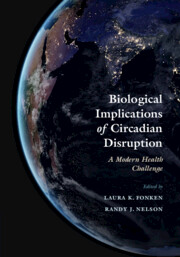Book contents
- Biological Implications of Circadian Disruption
- Biological Implications of Circadian Disruption
- Copyright page
- Contents
- Contributors
- Preface
- 1 Introduction to Circadian Rhythms
- 2 Central Clock Dynamics
- 3 Melatonin, Light, and the Circadian System
- 4 Disrupted Circadian Rhythms, Stress, and Allostatic Load
- 5 Disrupted Circadian Rhythms and Mental Health
- 6 Circadian Rhythms and Cognitive Functioning
- 7 Circadian Rhythm Disruption in Aging and Alzheimer’s Disease
- 8 Circadian Rhythms Regulate Neuroinflammation after Traumatic Brain Injury and Spinal Cord Injury
- 9 Disrupted Circadian Rhythms and Neuroendocrine Function in Fertility
- 10 Disrupted Circadian Rhythms and Metabolic Function
- 11 Disrupted Circadian Rhythms, Time Restricted Feeding, and Blood Pressure Regulation
- 12 Disrupted Circadian Rhythms and Immune Function
- 13 Circadian Rhythms and Cardiac Function
- 14 Disrupted Circadian Rhythms and Cancer
- 15 Light Effects across Species in Nature
- 16 Measurement and Analysis of Exposure to Light at Night in Epidemiology
- Index
- References
2 - Central Clock Dynamics
Daily Timekeeping, Photic Processing, and Photoperiodic Encoding by the Suprachiasmatic Nucleus
Published online by Cambridge University Press: 07 October 2023
- Biological Implications of Circadian Disruption
- Biological Implications of Circadian Disruption
- Copyright page
- Contents
- Contributors
- Preface
- 1 Introduction to Circadian Rhythms
- 2 Central Clock Dynamics
- 3 Melatonin, Light, and the Circadian System
- 4 Disrupted Circadian Rhythms, Stress, and Allostatic Load
- 5 Disrupted Circadian Rhythms and Mental Health
- 6 Circadian Rhythms and Cognitive Functioning
- 7 Circadian Rhythm Disruption in Aging and Alzheimer’s Disease
- 8 Circadian Rhythms Regulate Neuroinflammation after Traumatic Brain Injury and Spinal Cord Injury
- 9 Disrupted Circadian Rhythms and Neuroendocrine Function in Fertility
- 10 Disrupted Circadian Rhythms and Metabolic Function
- 11 Disrupted Circadian Rhythms, Time Restricted Feeding, and Blood Pressure Regulation
- 12 Disrupted Circadian Rhythms and Immune Function
- 13 Circadian Rhythms and Cardiac Function
- 14 Disrupted Circadian Rhythms and Cancer
- 15 Light Effects across Species in Nature
- 16 Measurement and Analysis of Exposure to Light at Night in Epidemiology
- Index
- References
Summary
Daily and seasonal rhythms are programmed by neural circuits that anticipate predictable changes in the environment (i.e., temperature, food, predation). The time and duration of daily light exposure is a strategic cue used to predict changes in the environment that determine fitness and survival. Light is transduced by a specialized visual system that serves as an irradiance detector. These inputs are processed and encoded by the suprachiasmatic nucleus (SCN), which serves as the body’s daily clock and annual calendar. The SCN encodes time-of-day and photoperiod to regulate downstream systems via multiple routes (e.g., melatonin, cortisol, feeding, body temperature). A deeper understanding of SCN timekeeping circuits, photoperiodic encoding mechanisms, and light-driven cellular adaptations is imperative for understanding plasticity and pathology in multiple biological systems.
- Type
- Chapter
- Information
- Biological Implications of Circadian DisruptionA Modern Health Challenge, pp. 23 - 57Publisher: Cambridge University PressPrint publication year: 2023

